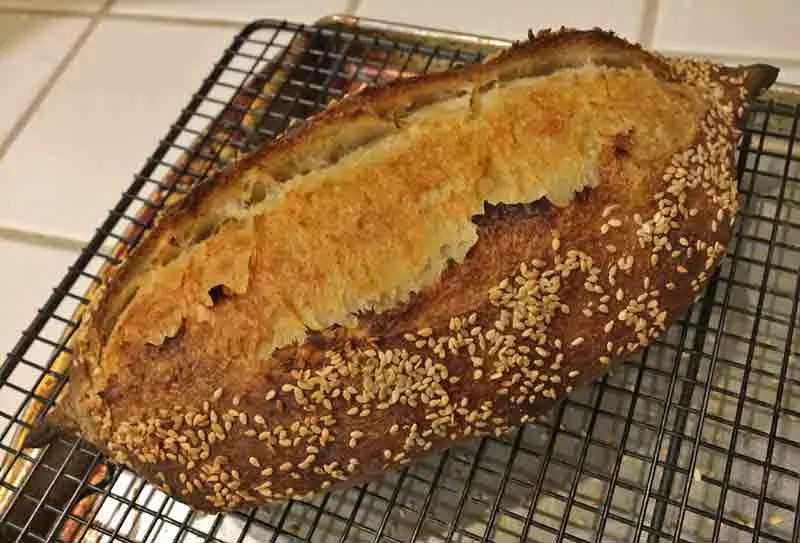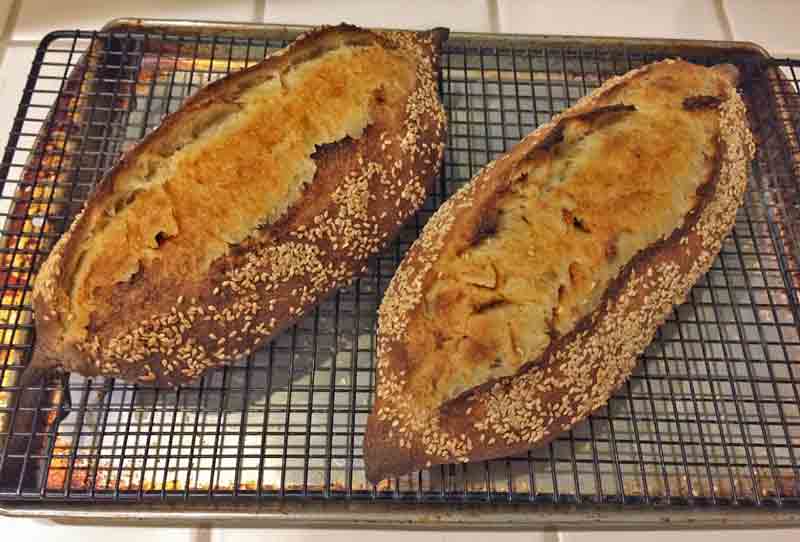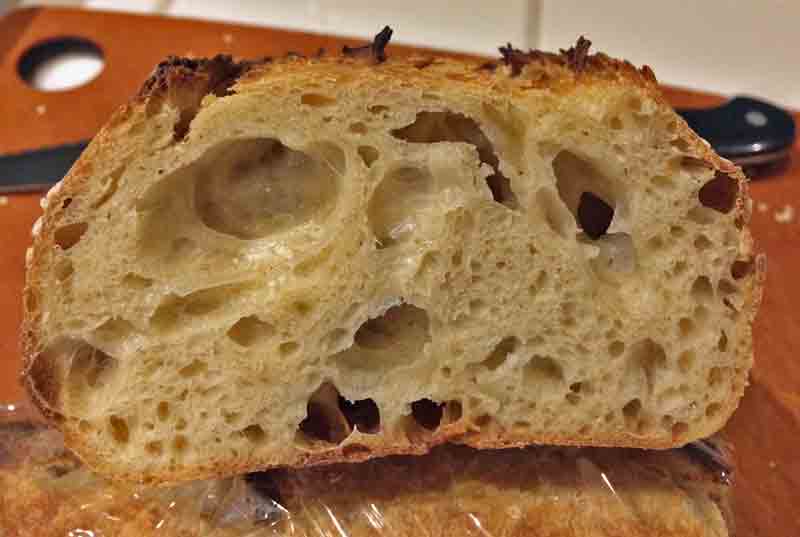
Sourdough Italian Bread: A SJSD Variant
David M. Snyder
October, 2017
This is one of my favorite breads. It uses the San Joaquin Sourdough method but a different flour mix and enrichment with a bit of sugar and olive oil. The dough is lovely to work with, and the flavor is scrumptious - both very tangy and rich. I have made a variety of breads with differing proportions of fine durum flour - from 10% to 100%. So far, I like the breads with 20-40% durum best, and this one best of all.
One warning: I have fed this bread to family members and to attendees at an Italian community potluck. Every time, I have observed many individuals coming back repeatedly for "just one more slice." It does not seem truly addictive. I have not observed any abstinence syndrome ("withdrawal"), but I would exercise caution when offering it to others - reserve a loaf for yourself.
Total Dough |
|
|
Ingredient | Amount (gms) | Bakers' % |
AP flour | 334 | 60.7 |
Fine Durum flour | 200 | 36.4 |
WW flour | 11 | 2 |
Whole Rye flour | 5 | 1 |
Water | 415 | 75 |
Salt | 10 | 1.8 |
Sugar | 14 | 2.5 |
EVOO | 14 | 2.5 |
Total | 1003 | 181.9 |
Liquid Levain |
|
|
Ingredient | Amount (gms) | Bakers' % |
Liquid starter | 40 | 40 |
Water | 100 | 100 |
AP flour | 70 | 70 |
WW flour | 20 | 20 |
Whole Rye flour | 10 | 10 |
Total | 240 | 240 |
Disperse the liquid starter in the water.
Add the flours and mix thoroughly.
Ferment at room temperature until expanded and bubbly (8-12 hours). If necessary, refrigerate overnight and let warm up for an hour before using.
Note: You will only use 100 g of the levain for this recipe. I usually make enough for more than one use. You can, of course, scale down the levain ingredients if you only want enough for this recipe.
Final Dough |
|
Ingredient | Amount (gms) |
AP flour | 300 |
Fine Durum flour | 200 |
Water | 365 |
Salt | 10 |
Sugar | 14 |
Active liquid levain | 100 |
EVOO | 14 |
Total | 1003 |
Procedures
In a large bowl, disperse the levain in the water.
Add the flours and sugar to the liquid and mix to a shaggy mass.
Cover the bowl and let it rest for 20-60 minutes.
Add the salt and olive oil and mix thoroughly. (Note: I squish the dough with my hands until it comes back together, then do stretch and folds in the bowl until it forms a smooth ball and the oil appears completely incorporated.)
Transfer the dough to a 2 quart lightly oiled bowl, and cover the bowl tightly.
After 30 minutes, do stretch and folds in the bowl.
After another 50 minutes, do a stretch and fold on a lightly floured board. Repeat after another 50 minutes.
Continue bulk fermentation for another 30-90 minutes, until the dough is puffy. If fermented in a glass bowl, you should see lots of little bubbles throughout the dough. Volume of the dough may have increased by 50% or so.
Refrigerate for 12-36 hours.
Divide the dough into 2 to 4 equal pieces and pre-shape as rounds or logs. Cover with a clean towel, baker's linen or plasti-crap and let rest for one hour.
Shape as Bâtards, Demi-Baguettes or Ficelles.
Roll the loaves on damp paper towels, then in a tray of sesame seeds. Alternatively, you can brush the loaves with water and sprinkle with sesame seeds.
Proof for about 45 minutes seam-side up on parchment paper or seam-side down on linen, pleated to separate the loaves and supported at both long sides by rolled-up dish towels. Cover with a damp towel, baker's linen or plasti-crap.
One hour before baking, pre-heat the oven to 480ºF with a baking stone and steaming apparatus in place.
When ready to bake, uncover the loaves. Pull the parchment (or linen) from both long sides to flatten out the pleats and separate the loaves.
Transfer the loaves, on the parchment, to a peel, or, if proofed on linen, transfer using a transfer peel. Seam side should now be down. Score them as baguettes or bâtards, according to their shape. Transfer them to the baking stone.
Steam the oven, and turn the temperature down to 460ºF.
After 12 minutes, remove the steaming apparatus. (Note: If you have a convection oven, switch to convection bake and turn the oven down to 435ºF for the remainder of the bake.) Continue baking for another 8-15 minutes or until the loaves are nicely browned and the internal temperature is at least 205ºF.
Transfer the loaves to a cooling rack. Cool completely before eating.


Enjoy!
David
- dmsnyder's Blog
- Log in or register to post comments
Very nice, as always, David. Would you mind if I featured this on the homepage for a while?
David
and it is very Italian for sure. It has to taste great and have that beautifu; yellow crust and crumb. Just perfrct
I hope my wedding loaves turn out half as nice. I'm using your SJSD at 12% whole grain total, 75% hydration and 12% prefermented flour 6 grains retarded bulk ferement. Half with Pepitas and sunflower and half plain. Could not think of a better recipe to use for a special occasion. Wish me luck
Happy baking David.
I'm honored you have chosen SJSD for such a joyous celebration. Mazel tov!
David
forgive my terminology deficit, I just want to be sure. . . by "liquid starter" do you mean a 100% hydration starter? just making sure.
those are beautiful, I so want one :D
Thanks!
~Scott
Your assumption is correct.
My liquid starter has exactly the same composition as the liquid levain described in my post.
If you do make this bread, let us know how it works for you.
Happy baking!
David
I'll definitely let you know how it goes
Another delightful bake with a beautiful creamy-looking interior. Similar to two past versions of yours. The Nov. 2013 70% hydration bake but doubling the durum here, and the May, 2015 ~73% hydration version.
I've already built a BBGA formula sheet for this, but it will have to be: after I start baking again, and queued up behind an FSWY FB#1 which will be a first time for me.
As with so many of your other batards, you certainly do have a signature look to them. Part of what makes this whole hobby so much fun.
I may have to put this on the "to bake" list but maybe sub some durum atta flour for the fine durum flour, since that is what I have on hand.
Paul
Wish I could taste it!
I"M NEW PHYTE WHEN SPOURDOUGH TOPIC IS THE SUBJECT..I ALWAYS FAILED QHEN I TRY TO DO IT. PLEASE ENLIGHTEN ME.
THANK YOU VERY MUCH !
Sorry typo error... i'm a newphyte when it comes to sourdough topic. i already tried many times, but no avail.
Please enlighten me with this amazing sourdough bread you post..
Thank you very much !
It stands for "extra virgin olive oil" - not a term peculiar to sourdough baking.
David
THANK YOU VERY MUCH !
BEST REGARDS,
... Spurred on by this discussion, and mindful of my limitations, I attempted an earlier version of your recipe, David, and it was quite a revelation in sensory delights! My recipe notes state "dough comes alive", "noticeable changes as it all comes together", "shaggy mass to silken cloth".
With a taste and crumb equal to the occasion (apart from my limited skills), I must thank you for directing me, unwittingly, to a "must keep" recipe! Next time I Must reduce initial baking time by a few minute to prevent over-caramelising the crust.
I'm happy you enjoyed it, and thanks for sharing!
The sugar in the dough, in particular, increases the risk of over-browning the crust. I set my timer for 2 or 3 minutes before I expect it to be done and check to prevent this. You can also lower the baking temperature a bit.
Happy baking!
David
I baked my first San Joaquin a few weeks ago following your two-way recipes posted early in October. It turned out better than I've expected. I can see how this variant will hit the same note with spectacular results. I like the texture of durum flour, adding the delightful mouthfeel and toasty texture that would be hard to beat. You're raising the bar once again. Thanks for posting yet another good one. It's on my to-bake list.
Dave, I am in the process of mixing your formula. But I don't think things are adding up.
For instance your total dough says 334 AP Flour. Then 70 AP Flour for the Levain. But the final dough shows 300 AP Flour. I work from a spreadsheet and things are not working out mathematically.
Take a look at the WW Flour in your formula. It appears a lot of ingredients are off.
I want to make sure I get your recipe right. Your breads are crazy good. I appreciate your post and have learned a lot from them.
-Dan Ayo
that he only uses 100 g of the Levain and that he makes extra?
spreadsheet that you are, assuming that you are using the BBGA template that I sent to you. The numbers work out pretty much to the gram. As Danni wrote, David states that he makes more levain than he will use in the formula.
alan
from residing on Isle TFL for long enough now. A formula is just that, sometimes with the step by step - which to me makes it a formula rather than a laundry list, and sometimes not.
Since everyone's own working environment is different, this is just the template guideline to introduce us to the author's way of making it in their own environment with their own brand of ingredients. Two ideal examples of this are
A second important component is the elephant in the room - the baker's own technique and skillset. Mostly no one on here can match the skills of a the fine fine full time bakers referenced here, like the Hamelmans & Hitzes, et al. Something to aspire to, but we just aren't anywhere there yet and likely never will be.
I understand that I'm being pedantic here, and likely preaching to the choir, but even those on TFL producing really fine work show their weak spots occasionally. Look no further than kendalm, who is regularly producing world class baguettes these days, but also isn't too shy to broadcast his failures to share.
Apologies if I've gone on too long, but once my typing engine got started...
alan
I just responded to Dan about why my spreadsheet for this mix ,which I sent to him, does not include the starter in the TDW.
the Q: Why is the starter (seed culture) never figured in to the equation?
my Response:
That starter in the TDW is what makes up the additional 20g that I account for when building “too much levain” on purpose. You’ll notice that the starter equals the difference between what I build and what I use. In the production world of Mr. Hamelman, the extra starter that is left over from “this morning’s mix” will be used later the same day to build tomorrow morning’s levain for tomorrow’s mix.
For a production environment, we can picture it this way: ...- Tue 6 PM: build levain from excess levain as the starter for Wed mix
- Wed 4 AM: bake Tue mix.
- Wed 6 AM: use planned, but excess levain from Tue 6 PM as ingredient in Wed mix.
... In David Snyder's layout above, he is building extra levain to be used down the road for "whatever", as he states in his notes. But he just as easily could have stated that will be using used extra levain as a starter to be incorporated into another levain build for the next SJSD Semolina mix. Hoping this clarifies something or other. And apologies to David for taking this conversation off track a little. alanI don't use a spreadsheet. Just my fingers and toes and, sometimes, a calculator. The numbers are correct, I think.
Did Danni's point (The final dough only uses 100 g or the 240 g of levain.) solve your mystery?
Another point of possible confusion: In calculating the ingredients in the "Total dough," I break out the ingredients in the starter and include them in the formula. I used to just put "Starter" in as a separate ingredient, but I think breaking it down gives a more accurate picture of the flour content and, perhaps as important, the true hydration.
So, for example, using this formula: The Final Dough uses 100 g of active levain. That levain is 100% hydration. This means it is half water and half flour. So, there is 50 g of flour in the levain. My levain flour mix is 70% AP, 20% WW and 10% Rye. So, the amount of AP in the levain is 50 g X 0.70 = 35 g. That gets added to the AP mixed into the Final dough. So, the total AP flour in the dough is 335. Note: that some rounding of numbers happens so I don't deal with fractions of grams.
David
I took me a while and "a little help from my friends", but I think I've arrived. :o)
The math didn't work out for me, because I failed to realize that the Total formula minus the Liquid Levain doesn't result in the Final Dough weight. This was because I did not take into account the 240g of starter. When I scaled the Levain down to 100g everything made sense.
I'm not sure I would have ever figured this out without the help of Danni, Alan, and Dave.
Thanks,
-Dan
Another teachable moment productively exploited!
I think that's how most of us have learned what we know - little pieces at a time.
Happy baking!
David
Hi David. I just saw this and want to try it. My question is about shaping as a boule. I haven’t tried making a batard or baguette and would love to bake in a Dutch oven. Not sure I have the skill set to shape it like yours. Any recommendations?
thanks Sharon
I can't think of any reason this shouldn't work as a boule baked in a DO. Just don't bake too hot. The sugar and oil in the dough will make a darker crust.
Advice: Learn to make a bâtard shape. There are many easy methods and lots of good instructional videos on youtube.
Happy baking! And let us know how it turns out for you.
David
Thanks David. I will try. I guess my concern is having it hold it’s shape. Oh well - trial by fire! I will keep you posted. I follow your posts all the time. I really want to try the rye bread as well and I have been looking for a bread recipe using durum, so that will be my next project.
I sent you a PM requesting the spreadsheet. I'm missing something.
-Dan Ayo
I'm hoping this clarifies your confusion.
David
I tried this and skillset fail? flat loves, great flavor but horrible presentation and crumb. I guess I need a few lessons.
Flat loaves can be due to several causes - insufficient lateral support during proofing, poor loaf forming, over-proofing, etc.
Photos of the loaf, including the crumb would help with problem solving.
David
Is my guess. Sadly I threw them out because my husband insisted on eating it anyway and it was making hi s stomach very unhappy. Definitely not over proofed, (maybe underproofed? - it got cold here) I need to find a good tutorial for loaf forming, Every time I try something that is not in a dutch oven it comes out flat. Clearly all me. I will persevere! thanks for responding. -Carolann
Please, if I may ask, when you say AP flour, what you are using? This is a difficult point for me at this moment...KAF AP is 'stronger' than most supermarket bread flours such as Goldmedal Better for Bread or Pillisbury Bread flour....and way different from GM or Pillsbury U AP flours....please make a suggestion what kind of AP flour I might use.
I would really like to make this bread...it looks beautiful!
Thank you so much.